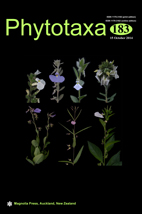Abstract
Two new species of Encyclia are proposed, E. silverarum and E. parkeri. Both species belong in the Encyclia chloroleuca complex, conformed also by E. chloroleuca, E. elegantula, and E. peraltensis, among others. Encyclia silverarum is known only from Panama. This species is very similar to Encyclia chloroleuca, but it is distinguished by the color of its sepals and petals (pale green-yellowish brown) and the falcate and proportionally short (<0.60 vs. >0.80 cm long) side lobes of the labellum. Encyclia parkeri, known only from Colombia (Department of Valle del Cauca), also is similar to Encyclia chloroleuca; however, it is distinguished by its flowers with olive-green to ocher petals and sepals, labellum creamy white, with the central lobe with many keels (at least three), all warty and usually slightly tinged red-purple.

